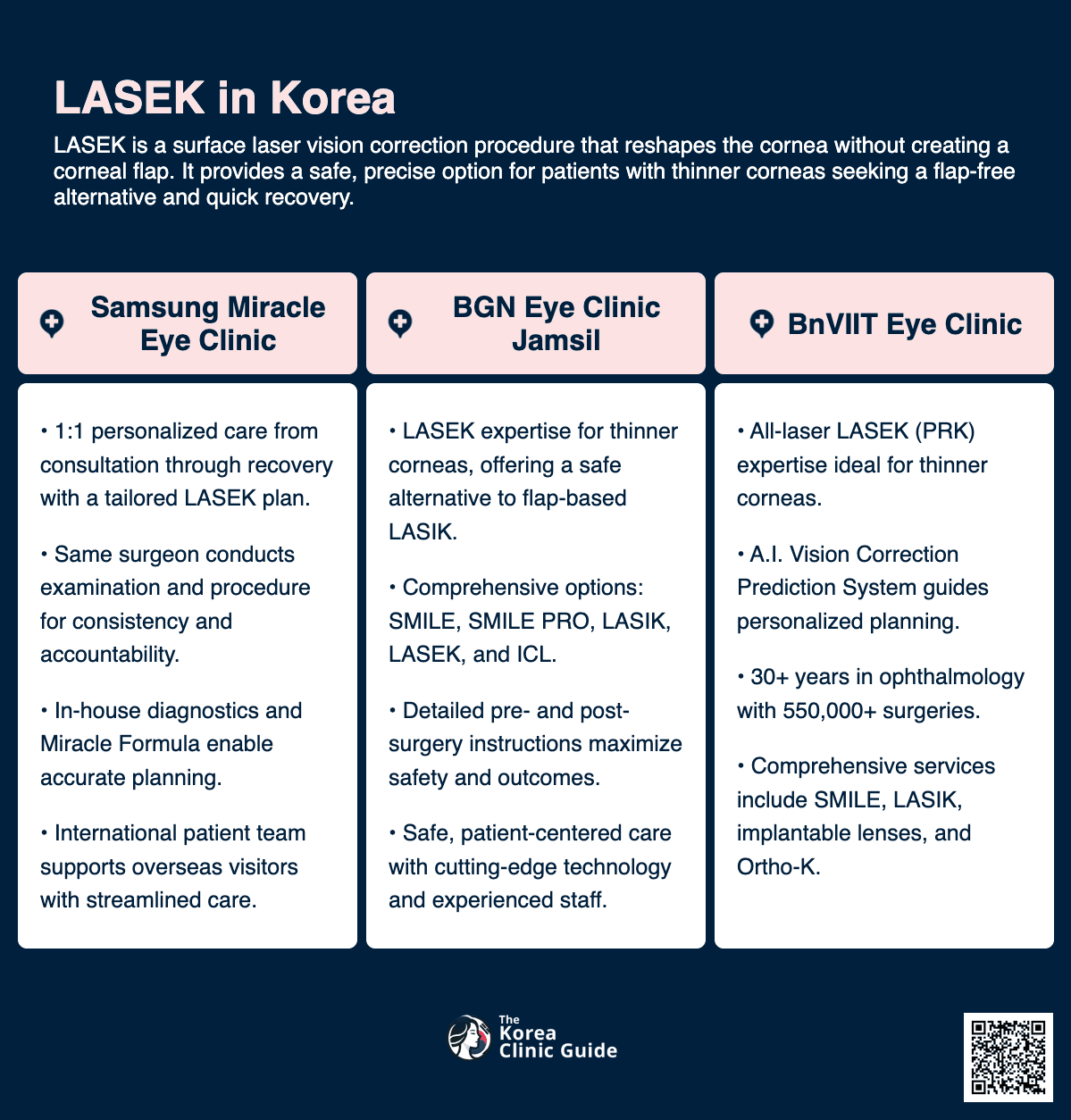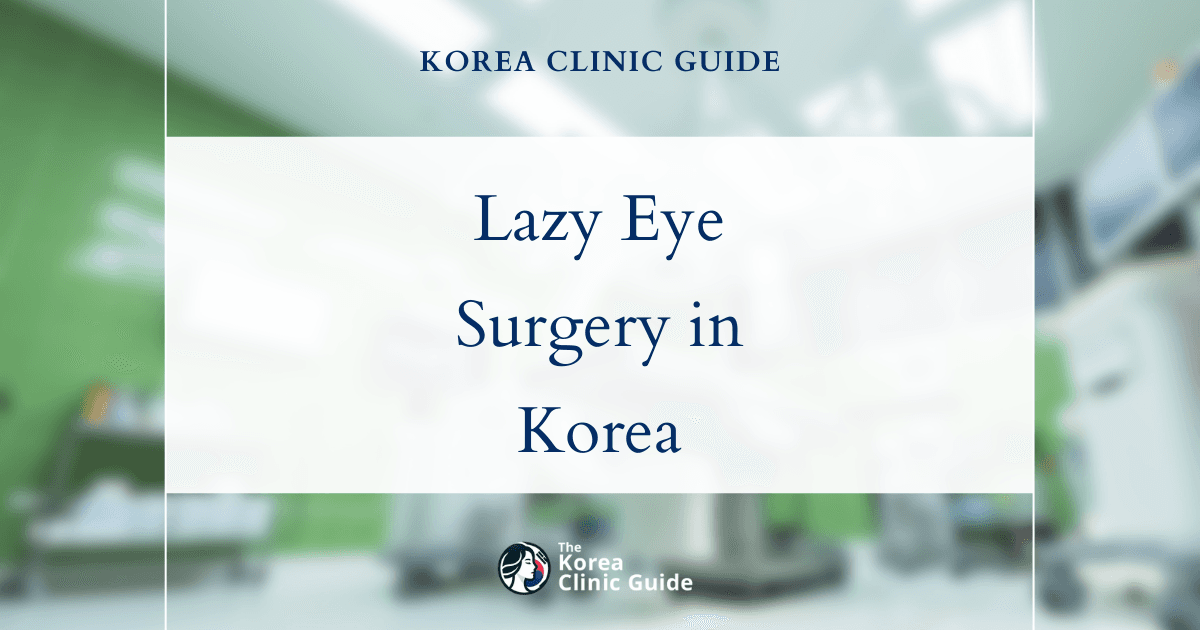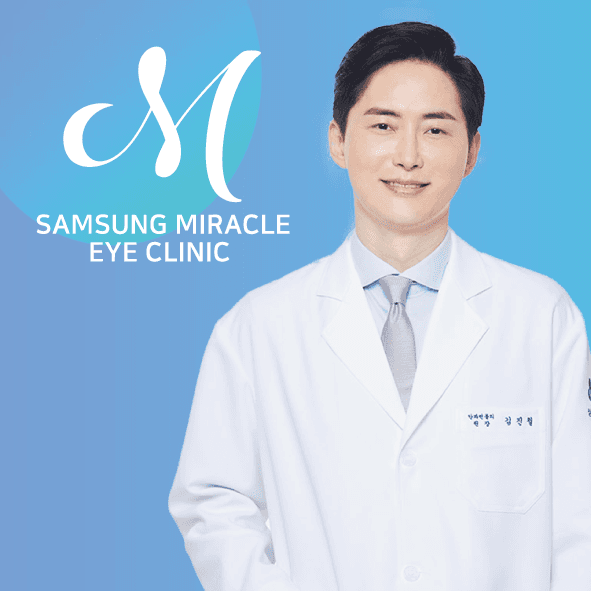Medical Tourism Blog
Hyperopia Solutions in Korea: Correcting Farsightedness with LASIK and LASEK Procedures

Table of contents
- Understanding Hyperopia and Its Correction
- Best Clinics in Korea for Hyperopia
- The Patient Journey: Getting Laser Eye Surgery in South Korea
- Financial Considerations and Comparative Analysis
- Real-World Outcomes for Hyperopia Patients
- Conclusion: An Informed Decision
- References
Considering treatment in Korea? Everything you need to know e.g. — how to avoid scams, visas, interpreters, recovery tips — in our Medical Tourism Master Guide. Plan with confidence in minutes, not weeks!
Understanding Hyperopia and Its Correction
Hyperopia: A Comprehensive Medical Overview
Hyperopia, commonly called farsightedness, makes it tough to focus on near objects while distant objects remain clearer. It’s not a disease but results from the eye’s shape, where the incoming light focuses behind the retina. A shorter than normal eyeball, a flatter cornea, or a lens pushed further back can all contribute. In serious cases, even distant vision blurs.
Terms like farsightedness, hypermetropia, and longsightedness all refer to hyperopia. Symptoms range from eye strain and headaches to squinting when reading or doing close work. Kids with hyperopia may avoid reading altogether. Age-related decline in the eye’s focusing power, known as presbyopia, can further worsen near vision for those around 40 and up. Many turn to surgical correction to rid themselves of glasses and contacts that might feel inconvenient or irritating.
Laser Vision Correction for Hyperopia: An In-Depth Look
Laser vision correction changes the shape of the cornea so light focuses correctly on the retina. LASIK and LASEK are the most common procedures—using similar technology but different surgical techniques.
LASIK (Laser-Assisted In Situ Keratomileusis): The Standard Bearer
LASIK involves creating a thin, hinged flap in the cornea using a precise blade or laser. This flap exposes the underlying tissue, which is then reshaped with an excimer laser to steepen the central cornea for hyperopia correction. The flap is then laid back down to heal naturally, requiring no stitches.
Ideal candidates for LASIK are adults with stable prescriptions and healthy, thick corneas. Conditions like chronic dry eye, active infections, or certain immune disorders may rule out eligibility.
LASEK (Laser-Assisted Subepithelial Keratectomy): The Flap-Free Alternative
LASEK offers a flap-free option and is particularly suited for some. Instead of making a permanent flap, surgeons apply an alcohol solution to loosen the eye’s surface (the epithelium), gently move it aside, and reshape the cornea with the laser. The surface layer is then replaced, and a bandage contact lens shields the eye while it heals for several days.
This approach is recommended for patients with thinner corneas or those at risk of trauma (like athletes), as no flap means less risk of displacement.
Comparative Analysis: LASIK vs. LASEK
The key difference is how each handles the corneal surface. LASIK’s flap means a faster, mostly painless recovery—often seeing improvement within a day. LASEK takes longer, with more discomfort and blurry vision for a week or so, but has advantages: no flap-related complications and less post-op dry eye.
For hyperopia, the required laser work on the peripheral cornea changes the eye’s shape more dramatically than for nearsightedness, raising the risk of weakening the already-thinner cornea. Since LASIK removes some tissue for the flap, this can be riskier for hyperopes, possibly leading to corneal ectasia. LASEK’s flap-free method leaves the cornea structurally stronger, making it a safer bet for many hyperopic patients—especially those with thinner corneas.
Best Clinics in Korea for Hyperopia
Listed below are the best clinics in Korea for hyperopia:
| Clinic Name | Key Features | Special Techniques |
|---|---|---|
| Samsung Miracle Eye Clinic Website | Samsung Miracle Eye Clinic, located at Gangnam Station, offers comprehensive care for hyperopia with 1:1 personalized consultations and fully customized surgical plans. The same doctor who examines you will perform your procedure and guide your recovery, ensuring consistency and accountability throughout. All surgeons are ambidextrous, operating with equal precision in both eyes to promote symmetry while minimizing contact with the nasal bridge for added comfort and safety. A dedicated International Patient Team supports visitors from abroad with the same standard of quality, convenience, and communication as local patients. For farsightedness, the clinic provides corneal laser options such as LASIK/LASEK, as well as lens-based solutions for patients with severe hyperopia or age-related changes, including presbyopia cataract treatment and intraocular lens insertion. Leveraging a cutting-edge in-house diagnostic system and a patented Miracle Formula for precise lens power calculation, Samsung Miracle Eye Clinic can complete diagnosis and surgery on the same day when appropriate, offering convenience without sacrificing accuracy. The center also offers SMILE LASIK, dry eye care, Dream Lens, and re-calibration surgery, delivering a comprehensive spectrum of vision services under one roof. | - LASIK/LASEK - Lens-based solutions including presbyopia cataract treatment and intraocular lens insertion - SMILE LASIK - Dry eye care - Dream Lens - Re-calibration surgery - In-house diagnostic system - Miracle Formula for lens power calculation - Same-day diagnosis and surgery when appropriate |
| BnVIIT Eye Clinic Website | With over 30 years of experience and 550,000 successful eye surgeries, BnVIIT (B&VIIT) Eye Center in Gangnam stands out as the best clinic in Korea for hyperopia care by combining proven expertise with a cutting-edge A.I. Vision Correction Prediction System and a truly comprehensive range of solutions. Patients with farsightedness can be matched to the right pathway, from minimally invasive SMILE and all-laser LASIK for reshaping the cornea, to all-laser LASEK (PRK) for those with thinner corneas, phakic intraocular lenses (PIOL) for higher refractive errors or laser ineligibility, advanced cataract surgery with artificial intraocular lenses when lens changes are present, and Ortho-K lenses for non-surgical, daytime clarity. Tailored customization options align each treatment with individual visual needs and lifestyle, ensuring precise planning, optimal outcomes, and high satisfaction—hallmarks that make BnVIIT the premier choice for hyperopia treatment in Korea. | - SMILE - All-laser LASIK - LASEK (PRK) - Phakic intraocular lenses (PIOL) - Advanced cataract surgery with artificial intraocular lenses - Ortho-K lenses - A.I. Vision Correction Prediction System |
| BGN Eye Clinic Jamsil Website | BGN Eye Clinic Jamsil is a premier eye care center in Korea delivering cutting-edge solutions for vision correction across the full spectrum of refractive needs, from laser procedures such as SMILE, SMILE PRO, LASIK, and LASEK to lens-based treatments including Implantable Collamer Lens (ICL) and cataract or presbyopia surgery, all supported by detailed pre- and post-surgery guidance—making it a standout destination for patients seeking safe, effective, and personalized options for farsightedness (hyperopia). | - Hyperopia-focused LASIK - LASEK for thin corneas - SMILE and SMILE PRO for myopia and astigmatism - ICL (implantable collamer lens) - Cataract surgery with monofocal intraocular lenses - Presbyopia surgery with multifocal intraocular lenses - Pre- and post-surgery instructions - Personalized treatment planning |
Samsung Miracle Eye Clinic
Samsung Miracle Eye Clinic, located at Gangnam Station, offers comprehensive care for hyperopia with 1:1 personalized consultations and fully customized surgical plans. The same doctor who examines you will perform your procedure and guide your recovery, ensuring consistency and accountability throughout. All surgeons are ambidextrous, operating with equal precision in both eyes to promote symmetry while minimizing contact with the nasal bridge for added comfort and safety. A dedicated International Patient Team supports visitors from abroad with the same standard of quality, convenience, and communication as local patients.
For farsightedness, the clinic provides corneal laser options such as LASIK/LASEK, as well as lens-based solutions for patients with severe hyperopia or age-related changes, including presbyopia cataract treatment and intraocular lens insertion. Leveraging a cutting-edge in-house diagnostic system and a patented Miracle Formula for precise lens power calculation, Samsung Miracle Eye Clinic can complete diagnosis and surgery on the same day when appropriate, offering convenience without sacrificing accuracy. The center also offers SMILE LASIK, dry eye care, Dream Lens, and re-calibration surgery, delivering a comprehensive spectrum of vision services under one roof.
You can check out their website here: Samsung Miracle Eye Clinic Website
BnVIIT Eye Clinic
With over 30 years of experience and 550,000 successful eye surgeries, BnVIIT (B&VIIT) Eye Center in Gangnam stands out as the best clinic in Korea for hyperopia care by combining proven expertise with a cutting-edge A.I. Vision Correction Prediction System and a truly comprehensive range of solutions. Patients with farsightedness can be matched to the right pathway, from minimally invasive SMILE and all-laser LASIK for reshaping the cornea, to all-laser LASEK (PRK) for those with thinner corneas, phakic intraocular lenses (PIOL) for higher refractive errors or laser ineligibility, advanced cataract surgery with artificial intraocular lenses when lens changes are present, and Ortho-K lenses for non-surgical, daytime clarity. Tailored customization options align each treatment with individual visual needs and lifestyle, ensuring precise planning, optimal outcomes, and high satisfaction—hallmarks that make BnVIIT the premier choice for hyperopia treatment in Korea.
Find more about this clinic here: BnVIIT Eye Clinic Website
BGN Eye Clinic Jamsil
BGN Eye Clinic Jamsil is a premier eye care center in Korea delivering cutting-edge solutions for vision correction across the full spectrum of refractive needs, from laser procedures such as SMILE, SMILE PRO, LASIK, and LASEK to lens-based treatments including Implantable Collamer Lens (ICL) and cataract or presbyopia surgery, all supported by detailed pre- and post-surgery guidance—making it a standout destination for patients seeking safe, effective, and personalized options for farsightedness (hyperopia).
- Hyperopia-focused LASIK: Laser-Assisted In Situ Keratomileusis reshapes the cornea to correct farsightedness as well as myopia and astigmatism, providing clear distance vision.
- Options for thin corneas: LASEK offers a laser vision correction pathway similar to LASIK but is specifically suitable for patients with thinner corneas who may not be ideal LASIK candidates.
- Comprehensive surgical spectrum: For patients who also have cataracts or presbyopia, cataract surgery with monofocal intraocular lenses and presbyopia surgery with multifocal intraocular lenses provide lens-based routes to clear vision at one or multiple distances.
- Cutting-edge technology and versatility: Alongside hyperopia-correcting LASIK, the clinic provides SMILE and SMILE PRO for myopia and astigmatism, underscoring advanced surgical capabilities and precision.
- Tailored care and safety: Detailed pre- and post-surgery instructions support a smooth recovery and help maximize outcomes across procedures.
- Personalized treatment planning: A broad portfolio—including ICL for high myopia and astigmatism in patients with thin corneas—enables truly individualized recommendations so that people with hyperopia receive the most appropriate pathway for their eyes and goals.
Find more about this clinic here: BGN Eye Clinic Jamsil Website
The Patient Journey: Getting Laser Eye Surgery in South Korea
The Process of Getting Procedure(s) in South Korea: A Step-by-Step Guide for Medical Tourists
Laser eye surgery in South Korea is streamlined and welcoming for international patients.
- Research and Initial Consultation: Patients usually start with online research and may work with agencies like Shin Medical. Clinics often offer free virtual consultations to discuss cases and eligibility before travel.
- Pre-Arrival Planning and Logistics: It’s smart to arrange travel and lodging early—most top clinics are in Seoul’s Gangnam district. Depending on trip length, a medical visa may be needed, and clinics can assist with paperwork. Patients should stop wearing contacts before surgery as instructed to ensure accurate results.
- In-Person Evaluation in South Korea: On arrival, expect thorough eye exams, including corneal mapping and medical review, to confirm suitability for surgery.
- The Procedure Day: Surgery day is quick and painless thanks to numbing drops, taking about 15-20 minutes for both eyes.
- Post-Operative Care and Recovery: Patients receive instructions and medications for aftercare. Most stay five to seven days for crucial follow-up visits and monitoring.
Why South Korea? A Medical Tourism Hub

South Korea’s eye clinics perform around 200,000 vision corrections each year, giving surgeons broad experience and access to the latest technology—sometimes even before it’s available elsewhere.
International patients benefit from English-speaking coordinators, translators, and all-inclusive packages that handle everything from tests to meds. This tight infrastructure, advanced equipment, and competitive pricing make the experience smooth and efficient.
The affordability comes from high patient volumes and a competitive market—not inferior care. These factors cycle together to lower costs, increase expertise, and improve outcomes, keeping South Korea at the forefront for medical tourists seeking quality and value.
Financial Considerations and Comparative Analysis
Cost of LASIK and LASEK in South Korea: A Detailed Breakdown
One of the biggest draws for foreign patients is lower cost. LASEK, generally the most affordable, averages ₩1.5 - ₩2.5 million KRW ($1,100 to $1,900 USD) for both eyes—sometimes as low as $760. LASIK costs similarly, depending on whether traditional or Femto-LASIK is used. Usually, prices cover pre-op exams, the procedure, and all aftercare meds, plus English-speaking support.
A Global Cost Comparison for the Medical Tourist
The price difference is significant compared to the West, making South Korea a top destination for value. Lower costs aren’t due to cut corners; Korean clinics maintain international standards and often have the latest laser equipment, thanks to their efficient, high-volume system.
| Procedure | South Korea (USD) | United States (USD) | Canada (USD) | United Kingdom (USD) | Australia (USD) |
|---|---|---|---|---|---|
| LASIK | $750 - $1,900 (both) | $1,500 - $5,000 (per eye) | $1,500 - $2,500 (per eye) | $2,000 - $3,300 (per eye) | $1,700 - $2,400 (per eye) |
| LASEK | $760 - $1,900 (both) | $1,500 - $2,500 (per eye) | $1,200 - $2,000 (per eye) | $1,600 - $2,600 (per eye) | $1,350 - $1,900 (per eye) |
Note: Figures are approximate and vary by clinic, technology, and experience.
Real-World Outcomes for Hyperopia Patients
Beyond the 20/20 Promise: Success and Satisfaction
Laser eye procedures consistently deliver, with over 99% of LASIK patients achieving 20/40 vision or better. Hyperopic patients see satisfaction rates of 96.3%. For many, success means less reliance on glasses and contacts—and the freedom to pursue daily activities with ease.
Patients’ stories echo these results, describing upgraded quality of life and everyday convenience, even when perfect 20/20 vision isn’t achieved. Improved confidence, easier work and hobbies, and relief from dry eyes or lens hassle are frequently cited benefits.
Addressing Unique Challenges for Hyperopia Correction
The Challenge of Regression
Regression—the slow return of farsightedness—is more common after hyperopic surgery than for nearsighted correction. Studies show a hyperopic shift averaging +0.53 D over five years, often because the cornea’s healing response can partially undo the laser work. Those with higher prescriptions might need a future enhancement or reading glasses.
Potential Side Effects and Complications
The most frequent side effect is temporary dry eye, affecting up to 70% of LASIK patients as the nerves recover. Other typical symptoms like glare, halos, and sensitivity usually fade with healing. Rare but serious risks include flap-related complications (like infection or displacement) and corneal ectasia, particularly for patients with high hyperopia and thin corneas. The adoption of femtosecond laser technology and thorough exams have further reduced these risks.
Managing Expectations
Patients with significant hyperopia should set realistic goals—not always 20/20, but a life-changing reduction in glasses or contacts. Healing may be slower than for nearsighted surgery, and some enhancement procedures may be needed down the line. Having frank discussions with a surgeon—and fully understanding the process—are the surest way to satisfaction.
Alternatives to LASIK and LASEK
If LASIK or LASEK isn’t suitable due to very high prescriptions, thin corneas, or other factors, there are good alternatives:
- Non-Surgical: Glasses and contact lenses remain reliable and widely accessible.
- Implantable Collamer Lens (ICL): Especially for high hyperopia or thin corneas, this involves placing a soft lens in the eye without changing the cornea.
- Refractive Lens Exchange (RLE): Like cataract surgery, replacing the eye’s lens with an artificial one—great for severe hyperopia or presbyopia.
- PRK (Photorefractive Keratectomy): Similar recovery to LASEK, with the surface layer removed before laser reshaping; good for thin corneas.
Conclusion: An Informed Decision
Laser eye surgery—especially LASIK and LASEK—offers reliable, transformative results for those with hyperopia, and South Korea provides outstanding quality, technology, and value for medical tourists. LASEK tends to be the safer choice for hyperopic patients, due to the preservation of corneal integrity. Hyperopic patients should expect a longer healing time and potential for visual regression. A thorough evaluation and realistic goal-setting will ensure the best outcomes for anyone considering this journey.
References
1, 2, 3, 4, 5.), 6, 7, 8, 9, 10, 11, 12, 13, 14, 15, 16, 17, 18, 19, 20, 21, 22, 23, 24, 25, 26, 27, 28, 29, 30, 31, 32, 33, 34, 35, 36, 37, 38, 39, 40, 41, 42, 43, 44, 45, 46, 47, 48, 49, 50, 51, 52, 53















